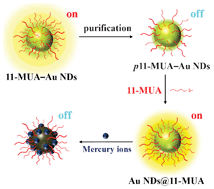Ligand effect on the luminescence of gold nanodots and its application for detection of total mercury ions in biological samples†
Abstract
In this study, we found that the photoluminescence (PL) of

* Corresponding authors
a
Institute of Bioscience and Biotechnology and Center of Excellence for Marine Bioenvironment and Biotechnology (CMBB), National Taiwan Ocean University, 2, Pei-Ning Road, Keelung, Taiwan
E-mail:
huanging@ntou.edu.tw
Fax: +011-886-2-24622034
Tel: +011-886-2-24622192 ext5517
b Department of Chemistry, National Taiwan University, Taipei, Taiwan
c
Department of Chemistry, National Changhua University of Education, Changhua City, Taiwan
E-mail:
linywjerry@cc.ncue.edu.tw
Tel: +011-886-4-7232-105 ext3553
d School of Pharmacy, College of Pharmacy, Kaohsiung Medical University, Kaohsiung, Taiwan
In this study, we found that the photoluminescence (PL) of

 Please wait while we load your content...
Something went wrong. Try again?
Please wait while we load your content...
Something went wrong. Try again?
H. Chang, H. Chang, Y. Hung, T. Hsiung, Y. Lin and C. Huang, RSC Adv., 2013, 3, 4588 DOI: 10.1039/C3RA23036H
To request permission to reproduce material from this article, please go to the Copyright Clearance Center request page.
If you are an author contributing to an RSC publication, you do not need to request permission provided correct acknowledgement is given.
If you are the author of this article, you do not need to request permission to reproduce figures and diagrams provided correct acknowledgement is given. If you want to reproduce the whole article in a third-party publication (excluding your thesis/dissertation for which permission is not required) please go to the Copyright Clearance Center request page.
Read more about how to correctly acknowledge RSC content.
 Fetching data from CrossRef.
Fetching data from CrossRef.
This may take some time to load.
Loading related content
